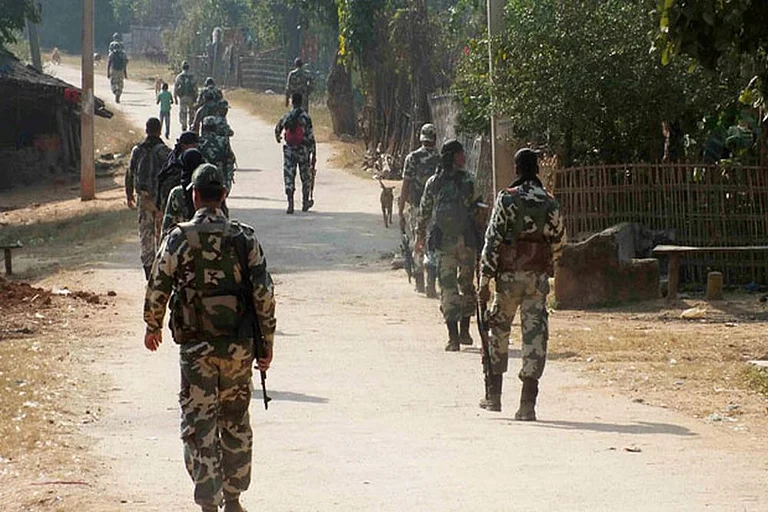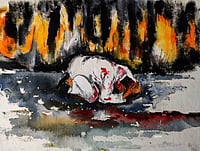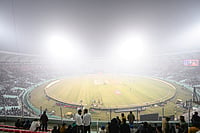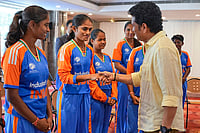In 1859, Delhi’s most famous poet, Mirza Asad Ullah Ghalib, was asked what Delhi was like these days. He replied: “My friend, what a question to ask! Five things kept Delhi alive—the Fort, the Chandni Chauk, the daily crowds at the Jama Masjid, the weekly walk to the Jumna bridge, and the yearly fair of the flower men. None of these survives, so how could Delhi survive?” Ghalib’s despondency notwithstanding, the fair celebrating the monsoon, known as the Phulwalon ki Sair or the Sair-e gulfaroshan, started again soon after the turmoil of the Revolt had died down and has survived until the present day.
What makes the Phulwalon ki Sair such a fascinating topic for the exploration of monsoon feelings is the density and variety of commentary it brought forth over the last two hundred years. These sources range from colonial reports to the no less matter-of-fact newsletters from the Mughal court. They include memoirs and essays recalling the world lost in 1857, and texts which depicted contemporary experiences up to the present day. Songs and poems were often included in other texts, but we also have a printed poem from 1876, which praises the joys of the Phulwalon ki Sair and was probably meant to be performed during the festival. Together they present a rich image from which we can reconstruct many of the basic facts of the festival, such as who the people were who went to Mehrauli and what they did there. But the sources go further.
They allow us an insight into the meaning different participants ascribed to the festival, and even into their emotions. Together they help us understand why Ghalib deemed the festival so important, not only for the identity but for the very survival of Delhi.
Though Ghalib had mourned over the demise of the Phulwalon ki Sair, it was resurrected after only a few years and soon recovered, if not its royal splendour, at least its attraction for the masses. These were the heydays of the festival as a popular celebration of the monsoon and its emotions. What Saiyid Ahmad Khan would only hint at—the coming together of the spiritual devotion and the erotic sentiments evoked by the rains—now became the central topic of the descriptions, of those reminiscing about the earlier festivals and those written for and about the present day.
Little is known today about Fazl ud-Din Dihlavi, the author of Bazm-e Akhir, ‘The Last Banquet’, first published in 1885. The only information we have is that he belonged to the entourage of Mirza Ilahi Bakhsh, a distant cousin of Bahadur Shah, who was recognised by the British as the head of the royal family after the fall of Delhi and the exile of the last of the Mughal rulers. It was his publisher who urged Fazl ud-Din to put down in writing his detailed knowledge about the palace before it was too late. This Fazl ud-Din did, in a writing style that was precise and unemotional—except when it came to the description of the Phulwalon ki Sair.
What fascinated Fazl ud-Din about Mehrauli was the crowds, the excess, and the whole hullabaloo of the exodus of half the city. Before the festival could start, not only the inhabitants of the palace, but also everything that was needed for the next days and weeks, including the carpets, spreads, curtains, decorations, etc., needed to be moved to Mehrauli. So did the artisans of the royal ateliers, but also all the women who worked in the palace. Soldiers accompanied the many different palanquins, carriages and chariots, blocking the streets in a confusion of humans, oxen, camels, horses and elephants, all the way down to Mehrauli.
Once the royal ladies arrived at Mehrauli, the entire space between the palace, the large lake called Shamsi Talab, the jharna and the Amuriyan became a zanana in which they could move freely, protected from all male gazes except Bahadur Shah’s. Some of the women began to hang up the swings, associated with the rainy season, others started cooking the dishes for which the festival was famous, while yet another group jumped into the jharna for a swim or enjoyed sliding down its slippery stone.
Fazl ud-Din described the traditional references to shringara rasa, the clouds, the peacocks, and the koyals, the lushness of the hills and trees that had recovered their greenery, the flowers that burst into bloom, the mangoes and jamuns which were so abundant that they fell from the trees before people could pluck them. This revelry brought together the nobility and the common people, Fazl ud-Din pointed out, the rich and the poor, the owners of shops and the bazaris: no one was left behind in the empty city of Delhi. All the houses were decorated and the food was rich and plenty, while the rain continued to drizzle softly.
The emotional experience was mediated through the senses of sight, of touch and of taste, but equally important were the sounds of the festival, the calling out of the shopkeepers, the songs of the ladies, and the musicians accompanying the processions, mainly nafiri trumpets, shahnais and a large variety of drums.
Other texts also invoked the presence of an entire naubat, travelling on an open platform. In Fazl ud-Din’s account, the emotions came to a culmination during the procession, which moved to the temple of Jogmaya on the first day and to the dargah of Qutb Sahib on the second day. The procession was led by the royal musketeers, followed by different professional groups. At the centre, right next to the elephants of the princes, were the flower-sellers and their pankhas, ornamented with a thousand flowers: “Look how packed the street is! People are falling over each other. A sweet drizzle is falling, and a cool wind is blowing. The bleating sound of the nafiris blares loudly. The pleasant forest and the crowd of people! In the evening the pankhas reach the royal palace with a lot of commotion.”
This excerpt is from Monsoon Feelings: A History of Emotions in the Rain, edited by Imke Rajamani, Margrit Pernau and Katherine Butler Schofield
Editor’s Note: The monsoon is a spectacle of nature. It is hard to believe that anyone could witness the massive clouds, pouring rains and colourful transformations in the flora without being, in any way, affected or moved by its force. One might assume that the cyclical arrival of the season, annually, over thousands of years has always evoked the same monsoon feelings.
This book presents a different vision of the monsoon and the feelings associated with the rainy season. Monsoon feelings have a history, which encompasses both continuity and change. To understand monsoon feelings, one has to ask: who experienced the monsoon, at which time, in which place, and through which cultural beliefs and practices?
In this book, we investigate the particularly rich, diverse, and changing history of monsoon feelings from the 12th century to the present. We establish a dialogue between different arts and traditions with a focus on the northern and western regions of the South Asian subcontinent. We explore how the monsoon has been experienced by writers and readers, musicians and their audiences, painters and those who look at miniatures, garden architects and the courtly users of their creations, producers of films and movie-goers, doctors and their patients, and those who rely on medical, religious and folk knowledge for their daily life.





















